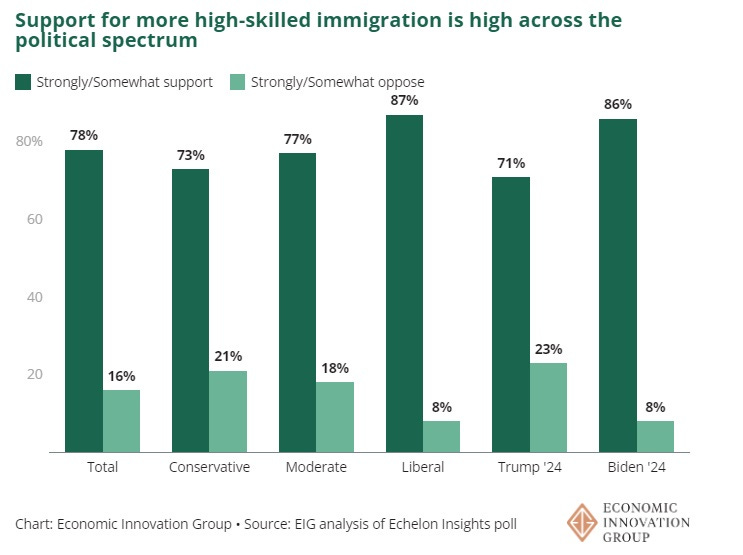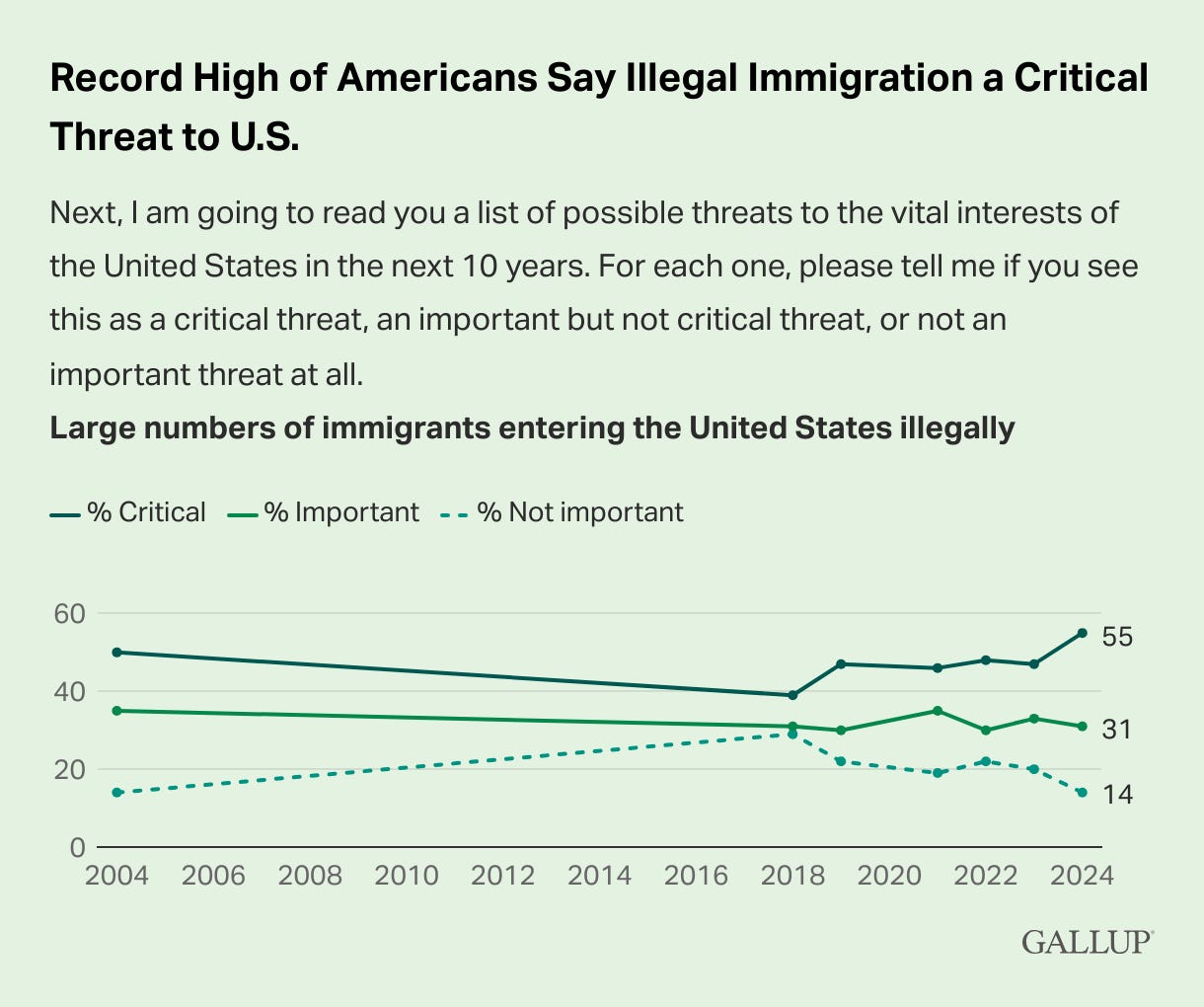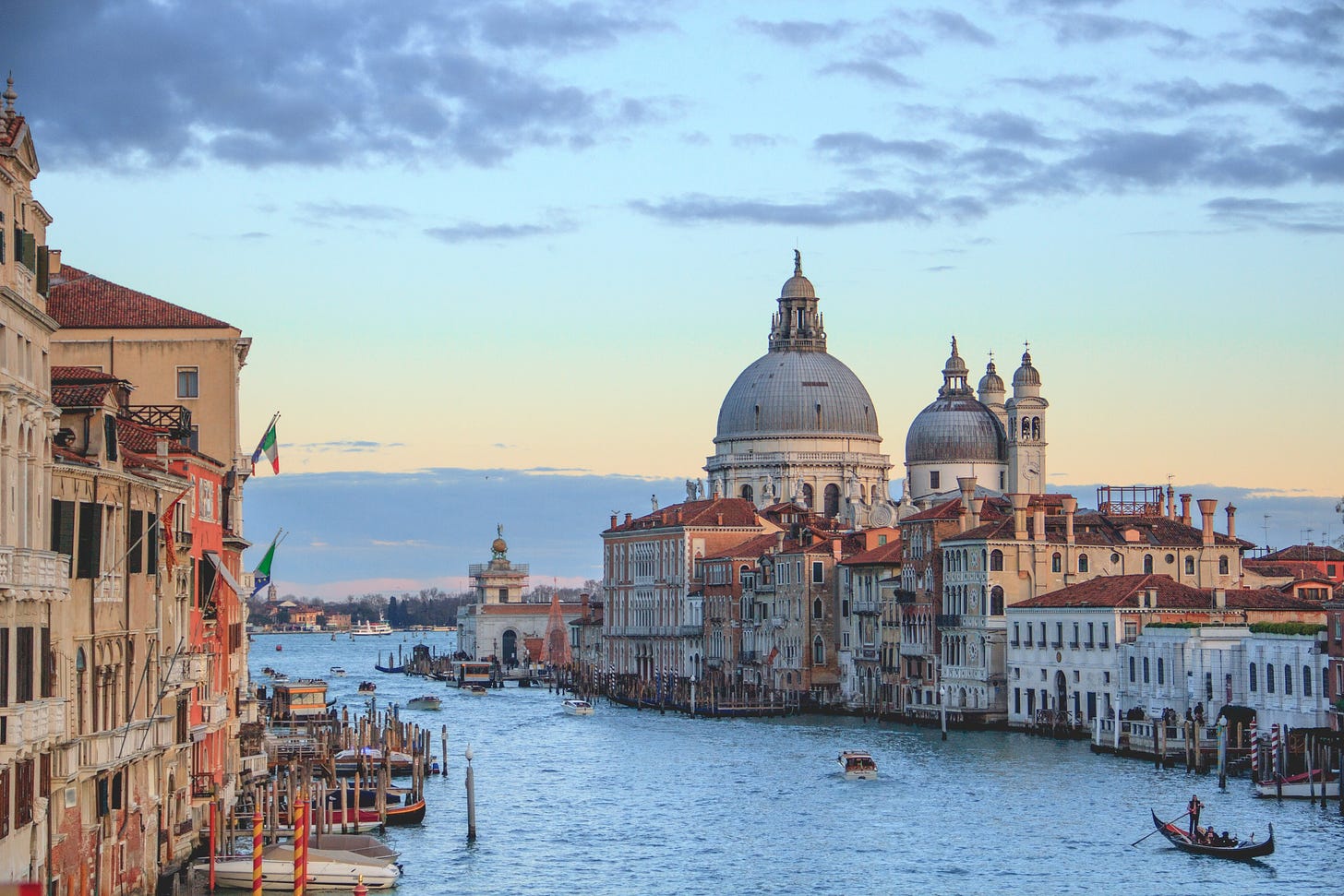America needs a skills-based immigration policy
And combine that with strict enforcement against illegal immigration.
American immigration policy is broken, and it has been broken for 60 years. And few politicians in either party propose a better system. Typically, politicians, pundits, and activists focus on how much immigration we should allow (legal and illegal), but very few of them focus on the far more important issue of what type of immigrants we should allow.
You would not know it from our immigration debate, but very few voters believe in:
Open borders or
Zero immigration.
The reality is that the vast majority of Democrats, Republicans, and Independents want some form of legal immigration, but the majority of them dislike illegal immigration. An increasing number of voters are outraged by the recent surge of illegal immigration during the Biden administration. Similar concerns wrack Europe. A feeling that current immigration policies are broken is widespread.
I believe this situation gives supporters of progress an opening for a completely new synthesis that is different from what both the Democratic and Republican parties want, but still very popular. And most importantly, that new synthesis could have a very positive long-term impact on economic growth while minimizing the real and perceived negative consequences of immigration.
Simply put, we need to combine:
A complete overhaul of American immigration policy that exclusively allows in highly-skilled workers who can make the greatest contributions to the nation. This means eliminating virtually all other types of legal immigration.
Strict enforcement against illegal immigrants both at the border and internally.
A nationalistic culture that demands that immigrants and their children assimilate into the broader American culture.
Unfortunately, few politicians, pundits, or activists support this combination of policies. Typically, those who want strict border enforcement say nothing about what types of immigrants we should be allowing into the country. And those who favor skills-based immigration completely ignore what we should do about illegal immigration and legal low-skilled immigration. I think this is a big miss.
We need to accept that there are only so many immigrants that we can absorb into the nation in any year. Polling in developing countries clearly shows that hundreds of millions, if not billions, of people want to immigrate to the United States. With true open borders or an unwillingness to enforce immigration rules, a sizable percentage of them will make the trip. And the more that arrive without repercussions, the more other immigrants will want to come.
The recent surge of illegal immigration since 2020 was likely at least partly due to the perception that the Biden administration was less willing to enforce border laws than the Trump administration. I think that any administration that does not take border enforcement seriously will get similar results.
So, those who favor a skills-based immigration policy need to face the fact that only a small percentage of immigrants who want to come to the United States will be able to do so. Therefore, a skills-based immigration policy is simply not viable without seriously simultaneously restricting low-skilled immigration (both legal and illegal).
It would be politically popular
I believe that this combination of reforms would be very popular with the American people. Voters in both parties strongly support highly skilled immigrants. The idea that Republicans would never support highly skilled immigrants is simply incorrect.
And illegal immigration is becoming increasingly unpopular, though much less so among Democrats.
Voter frustration about illegal immigration is getting so high that mass deportations are now back on the agenda.
In this article, I will not discuss how we strictly enforce against illegal immigrants, though I believe that it should be a fundamental component of any comprehensive immigration reform. Perhaps I will write a separate article on this topic at a later date, although I must confess I know less about this issue. Essentially, I am in favor of whatever policy produces results while being constitutional.
In this article, I will explain why we need a skills-based immigration policy, and how we can most easily implement it.
Most of the following is an excerpt from my second book Promoting Progress: A Radical New Agenda to Create Abundance for All. You can order my e-books at a discounted price at my website, or you can purchase full-price ebooks, paperback, or hardcovers on Amazon.
Other books in my “From Poverty to Progress” book series:
The importance of skills to material progress
In the first book in my book series, From Poverty to Progress, I made the case that we seriously underestimate the importance of skills in using and making technologies. Technological innovation plays a substantial role in promoting progress, but technologies cannot exist without related human skills.
While biological organisms can survive and reproduce without human intervention (except for some domesticated plants and animals), technologies cannot exist without human intervention. For it to survive and reproduce (by getting widely used by humans), technology requires humans to possess highly specialized skills.
Even the simplest technology needs some amount of skill to use. In addition, conceiving of the technology, designing it, building it, and repairing it are important related skills. Until people possess these skills, a specific piece of technology cannot come into being, or if it does, it will not last very long. It will certainly never spread far enough to become an important part of a society’s technological suite.
For this reason, the acquisition and transmission of new skills is a key bottleneck in the ability of technological innovation to deliver real progress for the masses. In other articles, I proposed reforms to our educational and job training systems to improve the skills required in the workforce, particularly for youths. In this article, I want to talk about the role that our immigration policy can play in boosting American skills.
Immigration is one of the most controversial domains of public policy. This should not be surprising, as nothing has a bigger impact on the future of a society than its people. By allowing certain types of people into a nation rather than others, you are shaping the future of your nation. Citizens want to take part in the discussion as to how we do so.
Skilled Immigration In the Past
Ever since the city states of medieval Northern Italy founded the first Commercial societies, the immigration of skilled workers has played an important role in sustaining progress. Skilled immigration enables talented people to relocate to societies where they can put their talents to the best use. When the most talented are given a chance to excel, everyone wins; the person wins, their families win, their community wins, and their nation wins.
Merchants, bankers, and artisans in Commercial societies were particularly mobile. Often starting their professions in small market towns, the most talented had the incentive to move to bigger cities with more opportunities.
The medieval apprenticeship system often created more artisans than could profitably work in cities. Masters recruited apprenticeships as workers for their workshops. The masters returned the favor by promising to train them and give them room and board. Once the apprentice had proven their talents, they became journeymen. Journeymen typically had the skills to run their own workshop, but they lacked the experience and the capital to do so.
Many journeymen chose to immigrate to other cities on the European continent. They had a strong incentive to go to cities where their particular skills were in greater demand than the local labor force could supply. In this way, skills in a particular technology naturally diffused from city to city throughout the continent.
Political instability and the oppression of minorities accelerated the migration of skilled workers. In the 16th Century, Antwerp was a highly innovative and competitive city with thriving export industries. When Spanish troops sacked the city in 1576 and massacred much of the population, a huge number of the skilled individuals who survived migrated as refugees to Dutch cities. These skilled immigrants laid the foundation for the Dutch Golden era. During the 17th Century, Dutch cities were the most economically competitive in the entire world, partly due to skilled immigrants from Flanders.
The repression of Protestants in France led to a massive flow of skilled refugees to England and the Netherlands. Each migrant brought valuable skills that enabled entirely new industries to spring up in those two nations. Skilled immigrants from Britain and what is now Germany played a substantial role in promoting the development of American industry.
Today, many of America’s largest and most innovative businesses were founded by immigrants or the children of immigrants. Apple was co-founded by Steve Jobs, the son of a Syrian immigrant. AT&T was founded by Alexander Graham Bell, who immigrated from Scotland and Canada. EBay was founded by Pierre Omidyar, who was born to Iranian parents in France. Google was co-founded by Sergey Brin, who is an immigrant from Russia. Tesla was founded by Elon Musk, an immigrant from South Africa. And this is just a partial list of the stunning contributions that highly-skilled immigrants have made to the American economy.
How the US immigration system works
Despite how controversial immigration policy is, very few American understand how the system actually. If you want to understand the basics, I would recommend reading this primer. The tables below come from that report.
Currently, U.S. immigration law is based on the following principles:
the reunification of families (the majority of legal immigrants)
admitting refugees and asylees
admitting skilled immigrants
while promoting diversity.
In many cases, these goals conflict with each other. If you assume that only a limited of legal immigrants can be allowed each year (which is the current policy), letting in immigrants from one category means one less immigrant from another category.
Family Reunification
Since the Immigration and Nationality Act of 1965, family reunification has been at the core of U.S. immigration law. Potential legal immigrants who have family members with American citizenship are strongly preferred over any type of other immigrant. In 2022, 58% of legal permanent residents were granted via family-based immigrant visas.
While the total number of immigrants is capped at 675,000 as of 2019, immediate family members are completely uncapped. This is not a trivial exclusion as, in the same year, more than 480,000 immigrants were allowed in for the purposes of family reunification. This exclusion from the overall cap almost guarantees that family reunification will dominant immigrant group.
Immediate relatives are officially defined as:
Spouses of U.S. citizens
Unmarried minor children of U.S. citizens (under 21 years old)
Parents of U.S. citizens
An additional limited number of visas (i.e. they are counted towards the overall cap) are available for the following extended family members:
Typically what this means is that an immigrant comes to the United States, whether illegally or legally, and then acquires American citizenship. Sometimes this is through the standard immigration process, while other times it is through periodic amnesties granted by Congress. The first immigrant can sponsor immediate family members, and then those family members can sponsor additional family members at a later date.
Implementing family reunification in this way has created the phenomenon of chain migration. All it takes is for one immigrant, illegal or legal, to eventually acquire American citizenship, for an entire extended family to do so in the following decades.
Most American citizens whose family members were not recent immigrants have very few relatives who live overseas. This is for the simple reason that American citizens tend to marry other American citizens. This seemingly mundane fact means that our immigration policy is unintentionally biased toward favoring the family members of recent immigrants over other American citizens.
Since immigration from 1965 until about 2007 was dominated by relatively unskilled Mexican immigrants, rules designed to promote family reunification have unintentionally promoted the legal migration of unskilled Mexican workers.
Refugees and Asylees
In addition to the above, each year Congress sets a numerical ceiling for refugee admissions. In 2024, the limit is 125,000. This cap is then broken down into separate limits by region. I am not going to talk much about refugees and asylees, except to say that:
few refugees and asylees are highly-skilled
the definition of the terms is so vague and subject to interpretation as to be easily evaded. With the proper coaching from immigration lawyers or NGOs, most people from developing nations can build a plausible case for a “well-founded fear of persecution.”
In addition to the above are a number of categories designed to promote humanitarian relief, including:
Temporary Protected Status (TPS): people who are in the United States but cannot return to their home country because of “natural disaster,” “extraordinary temporary conditions,” or “ongoing armed conflict” from specifically designated countries or regions within a country.
Deferred Enforced Departure (DED) provides protection from deportation for individuals whose home countries are unstable, therefore making return dangerous.
Deferred Action for Childhood Arrivals (DACA) permits certain individuals who were brought to the United States while under the age of 16 to remain in the US.
Humanitarian parole enables the executive to allow certain individuals to enter the United States, even though they may not meet the definition of a refugee.
Skills-based Immigration Today
Unfortunately, the level of highly-skilled legal immigrants is tiny in comparison. And remember that these limits listed below includes dependents, many of whom have few if any skills.
The United States is the nation where the most talented have the greatest chance of achieving personal success. That success not only benefits themselves and their families, but, if given a chance, it will also benefit their cities and the nation as a whole. Unfortunately, encouraging skilled immigration is only a very small part of current American immigration policy. And this is despite the fact that this type of immigration is the most popular type of immigration.
A Progress-based reform agenda should put promoting skilled immigrants to the United States to be at the core of our immigration policy.
The Impact of Immigration
The impact of immigration on American society is one of the most controversial issues in American politics. Multiculturalists and libertarians assert that virtually all immigration is good for the nation and that restricting immigration violates basic human rights. Nativists claim that almost all immigration is bad for the nation as it undermines American culture and creates competition that lowers wages.
Though I cannot possibly present evidence that would convince the true believers on either side, I believe the following:
Immigrants with high skills benefit American society because they:
generate more economic growth
pay more in taxes
consume far fewer government benefits
commit far fewer crimes
commit less violence
likely integrate faster into American society
are more likely to have children who do the same
Immigrants with low skills (both legal and illegal) provide, at best, mixed benefits for American society as they:
earn far lower incomes
pay much less in taxes
receive higher levels of government benefits
depress per capita GDP (though they increase GDP nominally)
likely take longer to integrate into American society
are more likely to have children that do the same
In addition, there is some evidence that they compete for jobs with low-skilled American jobs, making it more difficult for the existing working-class and poor candidates to earn a living wage in that locale.
Just to give a flavor of the differences we are talking about, let’s look at the net fiscal cost. The estimated lifetime differences based on age and education are enormous. For example, an immigrant that arrives between the ages of 25 and 34 with less than a high school education, the estimated net fiscal cost is $211,603. For the same immigrant with a graduate degree, the estimated net fiscal savings is $1,379.695.
That is more than a $1.5 million difference for just one immigrant! When we are talking about tens of millions of immigrations and their children over the decades that totals trillions of dollar in total.
Those who favor increased immigration often toss around statistics about the overall benefits of immigration while neglecting enormous discrepancies in the costs and benefits between different types of immigrants. This is particularly true on discrepancies based on skills.
Plain and simple: immigrants are not all the same. Some types of immigrants benefit the nation far more than others, and American citizens have the right to choose which ones to admit. Based on opinion polls, it is very clear that they prefer highly skilled immigrants over low skilled workers (legal and illegal).
Skills-based immigration
A new American immigration policy should shift the emphasis of legal immigration from family reunification and refugees to skills and economic benefits to the nation. A complete overhaul of American immigration policy is far beyond the scope of this article. Such a proposal would have to deal with border enforcement, amnesties, and many other issues that are not directly related to the concept of progress. In this article, I want to focus on policies that directly focus on promoting progress.
One possible way to promote progress via skilled immigration would be to copy Canada and Australia. Both nations have a point-based system that is largely designed to acquire as many skilled workers as possible. Some have proposed that we copy such a system. Such a proposal might eliminate all the special categories of immigrants, such as family-based immigrants, the diversity lottery, and separate quotas for refugees and asylum seekers. All immigrants would be placed into one points-based system.
I would be in favor of such a reform, but I do not see the need to overhaul immigration policy when we can offer more targeted reforms. Points-based systems are always highly complicated, as they try to balance many competing goals.
The goal of a Progress-based reform agenda should be to promote skill immigration as much as possible, without getting bogged down in all the implementation details that a comprehensive overhaul of immigration policy would require.
A few simple criteria
I believe that a Progress-based reform agenda should be based upon a few simple changes that would have sweeping effects. To keep the system as simple as possible, all legal immigrants must fulfill the following criteria:
Mastery of the English language (speaking, verbal comprehension, reading, and writing), and
One or more of the following:
A four-year college degree from an accredited university in an occupation that pays in the top third for bachelor’s degrees in the United States. The median earnings for workers with bachelor’s degrees are currently $67,005 per year and the 75th percentile is $106,004, so this should place the income cutoff at a little under $100,000 (in the US).
Demonstrated work experience in such an occupation.
The ability to pass skill-based tests that are necessary to be hired in such a field in the United States (discussed in my article on Merit).
Being the owner of a business that can realistically be relocated to the United States and employ at least one additional US worker each year for five years.
Be willing to invest at least $500,000 in establishing a new job-creating enterprise that employs at least 10 full-time unrelated US workers. Ideally, the amount should go towards manufacturing or physical infrastructure. Real estate should not count towards this amount.
.In other words, everyone admitted must communicate well in English and be highly skilled or willing to invest capital. Family members of American citizens could still be admitted under this new system as long as they still fulfill the above requirements. Refugees and asylum seekers could also still be admitted, as long as they fulfill the above requirements. No immigrants from these categories will be admitted, however, exclusively based on their being in those categories (as is currently the case). To prevent fraud, potential immigrants should be interviewed by industry experts or given skills-based tests.
In theory, every new immigrant could be a refugee or a family member, so this reform does not necessarily cut their numbers. It just sets two additional criteria for all potential legal immigrants.
We could also apply the rule to temporary residents who come to the United States for university schooling.
Who will these new immigrants be?
My guess is that the vast majority of legal immigrants will be admitted based on their earning potential. Though the 2015 report is now a little out of date, The Economic Value of College Majors by Georgetown University gives us a clear idea of which occupations will be favored by the new system.
Here is a key table from that report showing the top third of the 137 occupations examined in the report:
The data from the reports shows new legal immigrants under my proposed system will likely be dominated by:
engineers
doctors
economists
scientists
businessmen
entrepreneurs.
If the goal is to promote material progress in the United States, this is exactly the type of people who we should be encouraging to immigrate. A disproportionate percentage of them will likely be family members of American citizens or refugees, but most of them will not be.
Given how important intelligence is to success in these fields, the new immigrants will likely be far more intelligent than the current national average. Even if they cannot apply that intelligence to their chosen field, that asset will benefit themselves and the American nation. And given that intelligence is a highly heritable trait, this intelligence is likely to be passed on to their children and grandchildren.
Given the geographical dispersals of these occupations, most of these new immigrants will likely come from:
Europe
Canada, Australia, New Zealand
Israel
East Asia, particularly China, Japan, Taiwan and South Korea
South Asia, particularly India
with smaller numbers from Latin America, Africa, and the rest of Asia.
Given the gender and age dispersals of these occupations, new immigrants in this system will likely be young and middle-aged males with very few elderly immigrants or almost no children. The gender imbalance is a bit worrying, but I do not think this irreparably undermines my proposed reform.
The criterion is self-adjusting
One of the great benefits of using earning potential in a specific occupation as the dominant criterion is that it is self-adjusting. If we get too many workers in a specific field, market conditions will lower salaries, so rules will allow fewer immigrants from that occupation. If we get too few workers in a specific field, market conditions will raise salaries. As certain skills become obsolete or suddenly come into demand from employers, this will also show up in the data.
There is no need for immigration bureaucrats to guess what occupations will be in demand in the future. They can just look at the actual salary, which can be updated each year.
Temporary Pause to Immigration
One of the big concerns opponents of immigration express is that immigrants will be in competition for jobs with American citizens, and too many citizens will lose their jobs or have their wages pushed down. While the economy is growing rapidly, I do not think that this is a major concern, but the situation does change during times of recession when unemployment rates increase.
This is also a difficult situation for legal immigrants. During times of economic growth, immigrants can typically find a job relatively quickly. During a recession, however, this is far from the case. While immigrants who arrived a few years earlier may already have established career paths, immigrants who just arrived have no jobs, and no work experience in their new country.
To protect both American citizens and legal immigrants from temporary economic hardship, there should be a temporary pause to immigration when the unemployment rate is 50% higher than its average over the previous ten years. This would stop new immigrants from entering the United States during recessions and give the economy a few years to recover to more typical unemployment rates. This would make it much easier for new immigrants to find jobs.
Once the unemployment rate drops below the threshold, then those “lost slots” under the cap would be shifted to subsequent years so it would not lower the overall amount of legal immigration.
I believe that this would also have a positive effect when it comes to calming concerns about excessive immigration. People are much more likely to be concerned about economic competition from immigrants during times of sluggish economic growth. In general, during times of economic growth, such concerns are much lower as American citizens have much less trouble finding jobs.
Recruiting Overseas Talent
A major goal of every American embassy and consulate should be recruiting skilled workers to immigrate to the United States. The new immigration criteria would give them a simple framework for the type of worker that should be courted.
Paying for targeted advertising campaigns to increase awareness of the new rules would help those who can most benefit the United States to start thinking about the possibilities. Highly targeted speaking tours with professional and business associations should get out the word to the right people with relatively little expense.
In particular, we should recruit entrepreneurs of small businesses that have a real opportunity to grow if they are relocated to the United States. I personally know of a number of entrepreneurs who struggled to expand their businesses in Europe, immigrated to the United States, and then reestablished their businesses on our soil. Using the power of the internet, online supply chains, consignment, and domestic labor, they grew their small businesses into profitable enterprises that employed many American citizens. In doing so, they benefitted themselves, their family, their community, the American economy, and its tax base. This practice should be far more widespread.
There is no reason why large enterprises could not be courted as well. With abundant, affordable energy and housing, lower regulations and taxes and many skilled workers, large enterprises in Europe, Canada and Japan would have excellent reasons for relocating operations to the United States.
As labor costs rise, production in China is becoming increasingly expensive, so many corporations are seriously thinking about relocating. Lower value-added manufacturing that requires low-skilled and low-paid workers will probably relocate to Southeast Asia, but higher value-added sectors may seriously consider the United States. This is particularly true in energy-intensive fields that require skilled labor, for which there would be a strong incentive to relocate production facilities.
Recruiting skilled workers should be a particular focus in repressive regimes that are hostile to the United States. Embassies in Russia, China, Iran, Venezuela, Cuba, Belarus, and Nicaragua could simultaneously help to undermine the economic prospects of those regimes, provide safe harbor for refugees, and promote American economic development. We can thus simultaneously hurt our enemies and help ourselves.
Recruiting skilled workers should also be a priority in affluent nations that give fewer opportunities to the talented, for example, Europe. Here the primary problem is high taxes and regulations that make it hard to start up and scale a business.
In the past, talented Canadians and Europeans flocked to the United States searching for better opportunities, but our current immigration policy makes it much harder for them to do so. A combination of a skills-based immigration policy and active recruitment could bring a new wave of talented Europeans and Canadians to the United States.
Archipelago of Talent
With the exception of Sub-Saharan Africa, world populations are expected to start shrinking within the next few decades. The primary driving force of this change is fertility rates that are substantially below the replacement rate of 2.1. Europe and East Asia are particularly likely to see massively declining population levels over the next century. In the long run, even African populations will start declining.
The world’s progress over the last 200 years has been undergirded by expanding populations. Expanding populations has become such an ever-present phenomenon that we do not know what types of impact a declining population will have on society overall. Those shifts will likely be profound. Some will be good, and some will be bad.
One thing that is clear is that the overall balance of power will be disrupted by declining populations. China and Russia, in particular, are likely to see a drastic drop in their influence in the world over the course of this century due to declining populations.
Public policy to increase fertility rates seems unlikely to work, although my proposed Working Family tax credit may have some positive effects. Many nations have tried paying women to have more children, but these policies have not been very successful. Nor is it clear that pro-natal policies are worth the cost.
If nothing else, the declining human population will be a boon to the natural environment. Declining population combined with urbanization and highly productive agriculture will drastically reduce the land footprint of humanity on the natural environment.
The only method for fighting population decline that seems to have a reasonable chance of success is immigration. I believe that relatively high levels of immigration combined with a skills-based immigration policy will cement American power and influence over the next century.
Let’s assume that the following trends occur over the next few centuries:
Low fertility rates cause population declines almost everywhere in the world.
The most talented migrate to the United States for greater opportunities.
This migration causes the American population and the American economy to keep growing, perhaps the only nation that will experience such growth.
Because of ever-increasing levels of talent compared to the rest of the world, the American economy keeps booming. This then creates additional incentives for American policymakers to continue skilled immigration and incentives for the most talented to choose to move to the United States.
For the last 200 years, people have migrated from rural areas to cities for greater opportunities. The vast majority of this trend has been within nations. But what if we expand this trend internationally? What if the combination of the above forces makes the United States the top immigration destination for skilled workers?
What is going to disrupt this positive feedback loop? Well, bad politics, of course, but aside from that, I think that is a stable long-term trend.
In the distant future, let’s say the year 2120, I can foresee a world with a declining population, and the United States making up a higher and higher percentage of the world population. People may complain about American “hyper-power” today, but if this trend occurs, American influence will go far beyond even that. The United States might effectively become the metropolis for the entire world. Obviously, this is not a prediction of the future, but the scenario is not so implausible as it first might seem.
As populations in the rest of the world decline, this will lead to a “rewilding” of the rest of the world. Agriculture and rural areas will gradually decline in land use, and wild habitats will take their place. Tropical nations might see vast regrowth of forests.
What if the world population in the 2100s keeps declining (as it is projected to), while only one nation keeps growing and keeps getting more skilled? These two factors will probably become a self-sustaining feedback loop. A higher and higher percentage of the world’s population will live in the United States, while more and more land in other nations gets transformed back into wild habitat.
Of course, there are limits to the number of immigrants that the United States can support. But assuming that we can build houses fast enough and create enough jobs, the limit is actually quite high. The Mountain West and Great Plains are still almost devoid of population, with the exception of a few isolated cities. There are no fundamental geographical reasons why dozens of additional cities cannot grow in those regions.
This should be a long-term goal that both Greens and those who favor progress can get behind. Obviously, this will take centuries to accomplish, but it is a worthy long-term goal.
Most of the above is an excerpt from my second book Promoting Progress: A Radical New Agenda to Create Abundance for All. You can order my e-books at a discounted price at my website, or you can purchase full-price ebooks, paperback, or hardcovers on Amazon.
Other books in my “From Poverty to Progress” book series:

























Michael Magoon for President! These policy ideas are better than anything promoted by any political party this century.
The US is in the enviable position of having many of the most desirable people on earth wanting to move here for a better opportunity. This could be an amazing opportunity for these people, for Americans, and for humanity (as those best capable of promoting progress would be in the country where they are best able to).
On the other side of the coin…. We need to repeal the policy on asylum, enforce the borders, make it impossible (a felony?) to get welfare benefits if here illegally.
We could use legal aliens to shore up Social Security and Medicare, through the addition of millions of high earners and entrepreneurs, as well as by possibly increasing the FICA employer contribution for legal immigrants. This would create a positive argument.
The fact that this article could be characterized as controversial in the current mainstream discourse is both crazy and sad.All of these opinions are almost self-evident,if immigration wasn't so heavily politicized we would do a lot better,and unlike where trans ppl should pee or what sports should they play,getting better immigration policy is an important issue